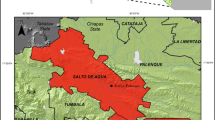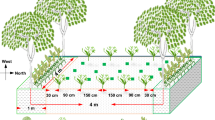Abstract
This study investigates the role of mango (Manifera indica L.) within agroforestry systems in Mangwende, Zimbabwe. Eighty two percent of households had mango trees. Neither the degree of natural woodland depletion nor the wealth status of a household had an influence on mango planting. Most mango trees were planted in the homefields. Mango trees provide fruit, firewood, poles, organic matter for soil amendment, living fence post, shade, soil conservation and cattle feed (the rotting fruits). Wealthy and poor households managed mango trees in the same way. Trees were pruned primarily to increase fruit yields and to reduce competition with crops, although prunings were utilised for firewood and poles. The relative importance of different uses of mango trees did not differ among households with different numbers of mango trees or with different wealth status, with fruits universally acknowledged as the most important product. Ninety four percent of households sold mangoes from their farms, but mangoes earned farmers the least income, in comparison with the four most important crops grown in Mangwende. Two thirds of households intercropped mangoes with herbaceous crops. The mangocrop associations were managed to optimise the yields of both crops and mangoes. Mango trees on croplands were widely perceived as having a positive effect on soil fertility and soil moisture and a negative effect on crop yield. About one third of the households used mango litter for soil amelioration, while litter from indigenous woodland was used by most households, especially in gardens.
Similar content being viewed by others
References
Campbell BM, Clarke JM and Gumbo DJ (1991) Traditional agroforestry practices in Zimbabwe. Agrofor Syst 14: 99–111
Campbell BM, Frost PGH, Kirchmann H and Swift M (1993) Nitrogen cycling and management of soil fertility in small-scale farming systems of Zimbabwe. Manuscript
Carter SE (1993) (ed) Soil fertility management in Mutoko Communal Area, Zimbabwe. Report of a field exercise, 12 August to 3 September 1992. Tropical Soil Biology and Fertility Programme. Nairobi, Kenya, 78 pp
Chambers R (1988) Direct Matrix Ranking in Kenya and West Bengal, pp 13–18. IIED, London
Chaudhri SA (1976)Mangifera indica-Mango. In: Garner RJ, Chaudhri SE and the staff of the Commonwealth Bureau of Horticulture and Plantation Crops. The Propagation of Tropical Fruit Trees, pp 403–474. Commonwealth Agricultural Bureaux, England
du Toit RF, Campbell BM, Haney RA and Dore D (1984) Wood Usage and Tree Planting in Zimbabwe's Communal Lands. Report produced for the Forestry Commission of Zimbabwe and the World Bank, 187 pp
Farrell J (1990) The influence of trees in selected agroecosystems in Mexico. In: Gliessman SR (ed) Agroecology: Researching the Ecological Basis for Sustainable Agriculture, pp 169–183. Springer-Verlag, New York
Fortmann L and Nabane N (1992b) Poverty and tree resources in Mhondoro District: A Research Note: CASS Occasional Paper Series — NRM., 8/92. Centre for Applied Social Sciences, University of Zimbabwe, Harare
Grant PM (1981) The fertilisation of sandy soils in peasant agriculture. Zimbabwe Agric J 78: 169–175
Gumbo DJ, Mukamuri BB, Muzondo MI and Scoones IC (1990) Indigenous and exotic fruit trees: why do people want to grow them? In: Prinsley RT (ed) Agroforestry for Sustainable Production: Economic Implications, pp 185–214. Commonwealth Science Council, London
Katerere Y (1987) Tree planting activities in rural Zimbabwe. In: ETC Foundation SADCC energy development: fuelwood study, Leusden, the Netherlands, annex I, 11 pp
Mandondo A (1993) Management and growth and survival ofEucalyptus camaldulensis in Murewa and Mutoko Districts of Zimbabwe. MSc Thesis, Department of Biological Sciences, University of Zimbabwe, Harare
McCracken JA, Pretty JN and Conway G (1988) An Introduction to Rapid Rural Appraisal Agricultural Development, International Institute for Environment and Development, London
McGregor JM (1991) Woodland resources: Ecology, policy and ideology, an historical case study of woodland use in Shurugwi Communal Area, Zimbabwe. PhD Thesis, Loughborough University of Technology, UK
Ministry of Agriculture (1985) Animal production systems project 3P-82-0134/4. First annual progress report, Farming Systems Research Unit, Harare
Ministry of Lands, Resettlement and Rural Development (1982) Study of the agricultural/rural development of Mashonaland East Province. Baseline survey and development strategy, Peter Thomas and Associates, Harare
Nyathi P and Campbell BM (1993) The acquisition and use of miombo litter by small-scale farmers in Masvingo, Zimbabwe. Agrofor Syst 22: 43–48
Opeke LK (1982) Tropical Tree Crops, pp 288–293. John Wiley and Sons, UK
Price L (1993) The effect of socio-economic factors on household tree holdings and seedling procurement practices in Samatanda and Chigaba Villages, Mutoko, Zimbabwe. MSc Thesis, Department of Biological Sciences, University of Zimbabwe, Harare
Purseglove JW (1968) Tropical Crops. Dicotyledons 1, pp 25–32. Longman Green and Company, UK
Ralhan PK, Singh A and Dhanda RS (1992) Performance of wheat as intercrop under poplar (Poplar deltoides Bartr.) plantations in Punjab (India). Agrofor Syst 19: 217–222
Rice RP, Rice RL and Tindall HD (1987) Fruit and Vegetable Production in Africa, pp 63–67. Macmillan, London.
Rocheleau D, Weber F and Field-Juma A (1988) Agroforestry in Dryland Africa. ICRAF. Nairobi, Kenya
Vincent V and Thomas RG (1960) An Agricultural Survey of Southern Rhodesia, Part I: Agroecological Survey. Government Printer, Salisbury
Author information
Authors and Affiliations
Rights and permissions
About this article
Cite this article
Musvoto, C., Campbell, B.M. Mango trees as components of agroforestry sytsems in Mangwende, Zimbabwe. Agroforest Syst 32, 247–260 (1995). https://doi.org/10.1007/BF00711713
Issue Date:
DOI: https://doi.org/10.1007/BF00711713




